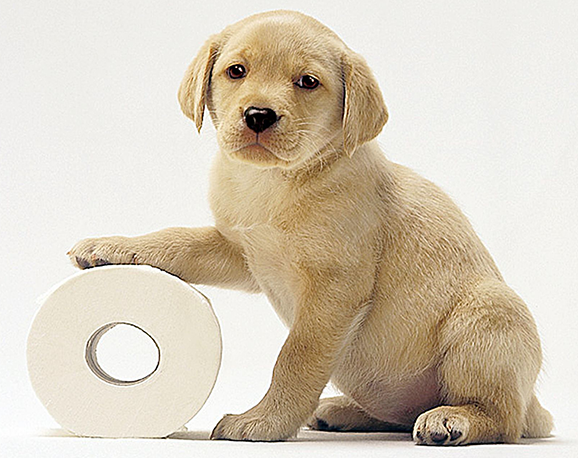You are here
Puppy House Training Tips By Dr. Ian Dunbar: How To Teach Your Puppy To Eliminate On Cue

How to house train a puppy? Why use a crate for house training? These are some of the most frequently asked questions we get day one of class at Sirius Puppy Training.
The success of teaching your puppy to pee and poop on cue depends on you being able to predict exactly when your puppy wants to relive himself. Then training is as easy as 1-2-3-4.
Whenever you’re at home, keep your puppy closely confined to a dog crate, or on leash tied to your belt or an eye-hook in the baseboard. Make sure your puppy has a stuffed Kong in the crate, or within reach when on leash. Maybe tie the Kong to the dog’s end of the leash or to the eyehook, so that it doesn’t roll out of reach.
Most people simply do not understand the principle behind close confinement and think that a dog crate is a place to leave puppies for hours on end. Others think that a crate is a cruel prison. Confinement procedures are only temporary and need not be cruel at all. Once your puppy is housetrained, he may have full run of your house for life. On the other hand, if you give your puppy unsupervised freedom too early, he will likely make mistakes around the house and then you’ll likely confine him to a single room or outdoors, where he will add more bad habits to his behavior repertoire, such as barking and digging. Once the neighbors complain of the barking, you’ll maybe confine him to the garage or basement. His quality of life is going down the toilet and the next step is likely to be further confinement to a 10 x 10’ shelter cage.
Remember, first confinement and then freedom, not vice versa.
Get your puppy housetrained so that he may enjoy the comforts of your home. I mean, what’s the point of getting a dog for companionship and security, if he’s going to live in the basement?
Additionally the reasons for close confinement and long-term confinement are completely different. The purpose of long-term confinement (a larger area, say a pen with a toilet) is: 1. To prevent mistakes around the house when you are away from home for more than an hour or two and 2. To maximize the likelihood that your pup will naturally learn to use the temporary indoor toilet with the appropriate substrate. The purpose of short-term confinement, such as a crate, when you are home is: 1. To prevent mistakes around the house and 2. For you to be able to predict when your puppy needs to eliminate. If you confine your puppy for an hour or two at a time, he will want to eliminate upon release. Most pups urinate within just 10-20 seconds because while he’s been lying down and chewing, his bladder has been gradually filling with urine and hurrying him to the toilet jiggles everything around and increases the urge to go. And so, when you are at home, confine your puppy to a crate and every hour on the hour, take your puppy to his toilet area.
Open the crate door, snap on the puppy’s leash (so your pup doesn’t get distracted run off), quickly walk to the toilet area and then:
- Say, “Go pee and poop”
- Stand still and wait
- As soon as your puppy starts to pee and/or poop
- Praise profusely as if your puppy has accomplished a most wonderful and amazing feat. As a rule of thumb, give three treats for a good pee, five treats for a poop and maybe a bonus treat for doing either quickly.
Now, go back indoors and have fun training and playing with your gloriously empty puppy for five or ten minutes before putting him back in his crate with a stuffed Kong for 50 minutes. Then repeat the procedure every hour on the hour that you are home. If your puppy does not eliminate when you take him to the toilet, put him back in the crate with a stuffed Kong and try again every 30 minutes. In no time at all, your puppy will be peeing and pooping at the drop of a hat.
I always relish speedy poopers. Without a doubt, my second Malamute, Phoenix, was the fastest pee-er and pooper on the Planet. In fact, I always wished that there were PeePoop Olympic Time Trials, so that I could have competed with her and won ribbons. One of the reasons that Phoenix was so fast, in the mornings I had a simple output-input rule — first you eliminate and then you get breakfast!
